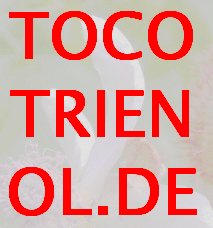Ich habe eine Webseite gemacht, die verschiedene natürliche Quellen von Vitamin E sortiert anzeigt, mit allen Isomeren.
Durch die Eingabefelder (und Klick auf die Überschriften) kann die Anzeige nach der Spalte sortiert werden.
Gemäß einer Studie aus Ägypten stellt sich Schwarzkümmelöl als bislang beste Quelle dar. Dieser hohe Wert konnte in einer Kontrolluntersuchung aber nicht bestätigt werden. Hier scheint es hohe Erntebedigte Schwankungen zu geben.
Die Daten sind aus verschiedenen Quellen zusammengestellt, Neuzugänge werden in der Kommentarspalte gekennzeichnet.
Folgende Spalten stehen zur Verfügung:
aT1 : alpha-Tocomonoenol
aTP : alpha-Tocopherol
bTP : beta-Tocopherol
gTP : gamma-Tocopherol
dTP : delta-Tocopherol
aT3 : alpha-Tocotrienol
bT3 : beta-Tocotrienol
gT3 : gamma-Tocotrienol
dT3 : delta-Tocotrienol
P-8 : Plastochromanol-8
T3 : Summe Tocotrienole
dmT3 : Summe desmethyl-Tocotrienole
%aTP : Prozentanteil alpha-Tocopherol an Gesamtsumme Vitamin E
Ich erhieltet dazu am 4.2.2018 folgenden Kommentar:
Kennen Sie diese Literatur-Hinweise?
Aus einem Artikel von Dr. Barrie Tan:
References
1. J.H. Ng and Tan B, “Analysis of Palm Oil Carotenoids by HPLC with Diode-Array Detection,” J. Chromat. Sci. 26 (9),463–469 (1988).
2. B. Tan, “Palm Carotenoids, Tocopherols and Tocotrienols,” J. Am. Oil Chem. Soc. 66,770–776 (1989).
3. B. Tan and L. Brzuskiewicz, “Separation of Tocopherol and Tocotrienol Isomers Using Normal- and Reverse-Phase Liquid Chromatography,” Anal. Biochem. 180 (2), 368–373 (1989).
4. “Tocols: 9631 through 9638,” in Merck Index (Rahway, NJ: Merck Publishing Group, 1996), pp. 1620–1621.
5. B. Tan, “Appropriate Spectrum Vitamin E and New Perspectives on Desmethyl Tocopherols and Tocotrienols,” JANA 8 (1), 35–42 (2005).
6. B.C. Pearce et al., “Hypocholesterolemic Activity of Synthetic and Natural Tocotrienols,” J. Med. Chem. 35 (20), 3595–3606 (1992).
7. B.L. Song and R.A. DeBose-Boyd, “Insig-Dependent Ubiquitination and Degradation of 3-Hydroxy-3-Methylglutaryl Coenzyme A Reductase Stimulated by Delta- and Gamma-Tocotrienols,” J. Biol. Chem. 281 (35), 25054–25061 (2006).
8. NobelPrice.org, http://nobelprize.org/nobel_prizes/medicine/laureates/1985/, in 2008.
9. B. Tan and A.M. Mueller, “Tocotrienols in Cardiometabolic Diseases,” in: R. Watson, Ed. Tocotrienols: Vitamin E Beyond Tocopherol (Urbana, IL, AOCS Press, 2008).
10.C.E. Elson et al., “Isoprenoid-Mediated Inhibition of Mevalonate Synthesis: Potential Application to Cancer,” Proc. Soc. Exp. Biol. Med. 221 (4), 294–311 (1999).
11. H. Mo and C.E. Elson, “Apoptosis and Cell-Cycle Arrest in Human and Murine Tumor Cells are Initiated by Isoprenoids,” J. Nutr. 129 (4), 804–813 (1999).
12. M. Sakai et al., “Apoptosis Induction by Gamma-Tocotrienol in Human Hepatoma Hep3B Cells,” J. Nutr. Biochem. 17 (10), 672–676 (2006).
13. Y. Mizushina et al., “Inhibitory Effect of Tocotrienol on Eukaryotic DNA Polymerase Lambda and Angiogenesis,” Biochem. Biophys. Res. Commun.339 (3), 949–955 (2006).
14. A.A.Qureshi, “Tocopherol Attenuates the Impact of Gamma-Tocotrienol on HMG-CoA Reductase Activity in Chickens,” J. Nutr. 126 (2), 389–394 (1996).
15. K. Kline, W. Yu and B.G. Sanders, “Vitamin E: Mechanisms of Action as Tumor Cell Growth Inhibitors,” J. Nutr. 131 (1), 161S–163S (2001).
16. A.A. Qureshi et al., “Dietary Alpha-Tocopherol Attenuates the Impact of Gamma-Tocotrienol on Hepatic 3-Hydroxy-3-Methylglutaryl Coenzyme A Reductase Activity in Chickens,” J. Nutr. 126 (2), 389–394 (1996).
17. S. Ikeda et al., “Dietary Alpha-Tocopherol Decreases Alpha-Tocotrienol but not Gamma-Tocotrienol Concentration in Rats,” J. Nutr. 133 (), 428–434 (2003).[ARN1]
18. T.J. Sontag and R.S. Parker, “Influence of Major Structural Features of Tocopherols and Tocotrienols on their Omega-Oxidation by Tocopherol-Omega-Hydroxylase,” J. Lipid Res. 48 (5), 1090–1098 (2007).
19. A. Stocker, “Molecular Mechanisms of Vitamin E Transport,” Ann. N Y Acad. Sci. 1031, 44–59 (2004).
20. H.M. Evans and K.S. Bishop, “On the Existence of a Hitherto Unrecognized Dietary Factor Essential for Reproduction,” Science, 56 (1458), 650–651 (1922).
21. M.K. Horwitt, “Vitamin E and Lipid Metabolism in Man,” Am. J. Clin. Nutr. 8, 451–461 (1960).
22. A.M. Mueller and B. Tan, “Tocotrienol in the Potential Treatment of Infectious Disease,” in: R. Watson R, Ed. Tocotrienol: Vitamin E Beyond Tocopherol (Urbana, IL, AOCS Press, 2008).
23. C. Villareal, J.A. Whittum-Hudson and A.P. Hudson, “Persistent Chlamydiae and Chronic Arthritis,” Arthritis Res. 4 (1), 5–9 (2002).
24. G.I. Byrne and M.V. Kalayoglu, “Chlamydia pneumoniae and Atherosclerosis: Links to the Disease Process,” Am. Heart J. 138 (5, Pt 2), S488–490 (1999).


